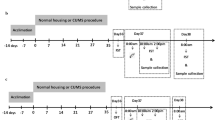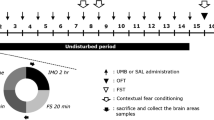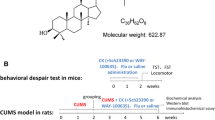Abstract
Depression is associated with a dysfunctional serotonin (5-hydroxytryptamine; 5-HT) system. More recently, several lines of evidence suggest that an important factor in the development of depression may be a deficit in the function and expression of 5-HT1A receptors. The present study assessed ifNelumbinis Semen (N. s.) had an anti-depression effect through reversing a decrease in 5-HT1A receptor binding in rats with depression-like symptoms induced by chronic mild stress. Using a 5-HT1A receptor binding assay, with a specific 5-HT1A receptor agonist, 8-OH-DPAT (8-hydroxy-2-(di-n-propylamino) tetralin), the mechanism of the anti-depression effect ofN. s. on rats was investigated, and the effects compared with two well-known anti-depressants,Hyperium Perforatum (St. Johns Wort) and fluoxetine (Prozac). Animals were divided into five groups: the normal (N) group without chronic mild stress (CMS), the control (C) group under CMS for 8 weeks, theNelumbinis Semen (N. s.) treatment group under CMS for 8 weeks, theHyperium Perforatum (H. p.) treatment group under CMS for 8 weeks and finally, the fluoxetine (F) treatment group under CMS for 8 weeks. Each treatment was administered to rats during the last 4 weeks of the 8-week CMS. A sucrose intake test was performed to test the anti-depression effect ofN. s. TheN. s. treatment significantly reversed the decreased sucrose intake under CMS (P<0.05 compared to control group under CMS). In the CA2 and CA3 regions of the hippocampus, bothN. s. andH. p. reversed the CMS-induced decrease in 5-HT1A receptor binding. In the I to II regions of the frontal cortex,N. s. andH. p. also reversed the CMS-induced decrease in 5-HT1A receptor binding, and even showed a significant increase in 5-HT1A receptor binding compared to the F treatment group (N. s. vs. P, p<0.05,H. p. vs. P, p<0.05). However, in the hypothalamus, all treatments reversed the CMS-induced decrease in 5-HT1A receptor binding. This reversal effect ofN. s. on the decrease in 5-HT1A receptor binding in the frontal cortex, hippocampus and hypothalamus of rat brains was very similar to that ofH. p, but different from that of F. It is concluded thatN. s. presents an anti-depression effect through enhancing 5-HT1A receptor binding.
Similar content being viewed by others
References
Ase, A. R., Amdiss, F., Hebert, C., Huang, N., van Gelder, N. M., and Reader, T. A., Effects of antipsychotic drugs on dopamine and serotonin contents and metabolites, dopamine and serotonin transporters, and serotonin1A receptors.J. Neural Transm, 106, 75–105 (1999).
Banasr, M., Hery, M., Printemps, R., and Daszuta, A., Serotonin-induced increases in adult cell proliferation and neurogenesis are mediated through different and common 5- HT receptor subtypes in the dentate gyrus and the subventricular zone.Neuropsychopharmacology, 29, 450–460 (2004).
Bench, C. J., Friston, K. J., Brown, R. G., Scott, L. C., Frackowiak, R. S., and Dolan, R. J., The anatomy of melancholia-focal abnormalities of cerebral blood flow in major depression.Psychol. Med., 22, 607–615 (1992).
Buhot, M. C., Martin, S., and Segu, L., Role of serotonin in memory impairment.Ann. Med., 32, 210–221 (2000).
Butterweck, V., Jurgenliemk, G., Nahrstedt, A., and Winterhoff, H., Flavonoids from Hypericum perforatum show antidepressant activity in the forced swimming test.Planta. Med., 66, 3–6 (2000).
Butterweck, V., Wall, A., Lieflander-Wulf, U., Winterhoff, H., and Nahrstedt, A., Effects of the total extract and fractions of Hypericum perforatum in animal assays for antidepressant activity.Pharmacopsychiatry, 30 Suppl 2, 117–124 (1997).
Celada, P., Puig, M., Amargos-Bosch, M., Adell, A., and Artigas, F., The therapeutic role of 5-HT1A and 5-HT2A receptors in depression.J. Psychiatry Neurosci, 29, 252–265 (2004).
Devanand, D. P., Pelton, G. H., Marston, K., Camacho, Y., Roose, S. P., Stern, Y., and Sackeim, H. A., Sertraline treatment of elderly patients with depression and cognitive impairment.Int. J. Geriatr Psychiatry, 18, 123–130 (2003).
Dremencov, E., Gur, E., Lerer, B., and Newman, M. E., Effects of chronic antidepressants and electroconvulsive shock on serotonergic neurotransmission in the rat hippocampus.Prog. Neuropsychopharmacol. Biol. Psychiatry, 27, 729–739 (2003).
Drevets, W. C., Frank, E., Price, J. C., Kupfer, D. J., Greer, P. J., and Mathis, C., Serotonin type-1A receptor imaging in depression.Nucl. Med. Biol., 27, 499–507 (2000).
Drevets, W. C., Frank, E., Price, J. C., Kupfer, D. J., Holt, D., Greer, P. J., Huang, Y., Gautier, C., and Mathis, C., PET imaging of serotonin 1A receptor binding in depression.Biol. Psychiatry, 46, 1375–1387 (1999).
Elena Castro, M., Diaz, A., del Olmo, E., and Pazos, A., Chronic fluoxetine induces opposite changes in G protein coupling at pre and postsynaptic 5-HT1A receptors in rat brain.Neuropharmacology, 44, 93–101 (2003).
Haddjeri, N., Blier, P., and de Montigny, C., Long-term antidepressant treatments result in a tonic activation of forebrain 5-HT1A receptors.J. Neurosci., 18, 10150–10156 (1998).
Hasrat, J. A., De Bruyne, T., De Backer, J. P., Vauquelin, G., and Vlietinck, A. J., Isoquinoline derivatives isolated from the fruit of Annona muricata as 5-HTergic 5-HT1A receptor agonists in rats: unexploited antidepressive (lead) products.J. Pharm. Pharmacol., 49, 1145–1149 (1997).
Katz, R. J., Animal models and human depressive disorders.Neurosci. Biobehav. Rev., 5, 231–246 (1981).
Katz, R. J., Animal model of depression: pharmacological sensitivity of a hedonic deficit.Pharmacol. Biochem. Behav., 16, 965–968 (1982).
Keck, B. J. and Lakoski, J. M., Region-specific serotonin1A receptor turnover following irreversible blockade with EEDQ.Neuroreport, 7, 2717–2721 (1996).
Khalifa, A. E., Hypericum perforatum as a nootropic drug: enhancement of retrieval memory of a passive avoidance conditioning paradigm in mice.J. Ethnopharmacol., 76, 49–57 (2001).
Kline, A. E., Yu, J., Horvath, E., Marion, D. W., and Dixon, C. E., The selective 5-HT(1A) receptor agonist repinotan HCI attenuates histopathology and spatial learning deficits following traumatic brain injury in rats.Neuroscience, 106, 547–555 (2001).
Leitch, M. M., Ingram, C. D., Young, A. H., McQuade, R., and Gartside, S. E., Flattening the corticosterone rhythm attenuates 5-HT1A autoreceptor function in the rat: relevance for depression.Neuropsychopharmacology, 28, 119–125 (2003).
Leonard, B. E., Pharmacological differences of serotonin reuptake inhibitors and possible clinical relevance.Drugs, 43 Suppl 2, 3–9; discussion 9-10 (1992).
Li, G. R., Li, X. G., and Lu, F. H., Effects of neferine on transmembrane potentials of guinea pig myocardium.Zhongguo Yao LiXue Bao, 10, 406–410 (1989).
Li, G. R., Qian, J. Q., and Lu, F. H., Effects of neferine on heart electromechanical activity in anaesthetized cats.Zhongguo Yao Li Xue Bao, 11, 158–161 (1990).
Lozoya, X., Meckes, M., Abou-Zaid, M., Tortoriello, J., Nozzolillo, C., and Arnason, J. T., Quercetin glycosides in Psidium guajava L. leaves and determination of a spasmolytic principle.Arch. Med. Res., 25, 11–15 (1994).
MacQueen, G. M., Campbell, S., McEwen, B. S., Macdonald, K., Amano, S., Joffe, R. T., Nahmias, C., and Young, L. T., Course of illness, hippocampal function, and hippocampal volume in major depression.Proc. Natl. Acad. Sci. U.S.A., 100, 1387–1392 (2003).
Monleon, S., D’Aquila, P., Parra, A., Simon, V. M., Brain, P. F., and Willner, P., Attenuation of sucrose consumption in mice by chronic mild stress and its restoration by imipramine.Psychopharmacology (Berl), 117, 453–457 (1995).
Muller, W. E., Rolli, M., Schafer, C., and Hafner, U., Effects of hypericum extract (LI 160) in biochemical models of antidepressant activity.Pharmacopsychiatry, 30 Suppl 2, 102–107 (1997).
Muscat, R., Papp, M., and Willner, P., Reversal of stress-induced anhedonia by the atypical antidepressants, fluoxetine and maprotiline. Psychopharmacology (Berl), 109, 433–438 (1992).
Nieto-Sampedro, M., Shelton, D., and Cotman, C. W., Specific binding of kainic acid to purified subcellular fractions from rat brain.Neurochem. Res., 5, 591–604 (1980).
Nowak, G., Szewczyk, B., Wieronska, J. M., Branski, P., Palucha, A., Pilc, A., Sadlik, K., and Piekoszewski, W., Antidepressant-like effects of acute and chronic treatment with zinc in forced swim test and olfactory bulbectomy model in rats.Brain Res. Bull., 61, 159–164 (2003).
Papp, M., Willner, P., and Muscat, R., An animal model of anhedonia: attenuation of sucrose consumption and place preference conditioning by chronic unpredictable mild stress.Psychopharmacology (Berl), 104, 255–259 (1991).
Protais, P., Arbaoui, J., Bakkali, E. H., Bermejo, A., and Cortes, D., Effects of various isoquinoline alkaloids on in vitro 3H- dopamine uptake by rat striatal synaptosomes.J. Nat. Prod., 58, 1475–1484 (1995).
Radja, F., Descarries, L., Dewar, K. M., and Reader, T. A., Serotonin 5-HT1 and 5-HT2 receptors in adult rat brain after neonatal destruction of nigrostriatal dopamine neurons: a quantitative autoradiographic study.Brain Res., 606, 273–285 (1993).
Sargent, P. A., Kjaer, K. H., Bench, C. J., Rabiner, E. A., Messa, C., Meyer, J., Gunn, R. N., Grasby, P. M., and Cowen, P. J., Brain serotonin 1A receptor binding measured by positron emission tomography with [11C]WAY-100635: effects of depression and antidepressant treatment.Arch. Gen. Psychiatry, 57, 174–180 (2000).
Shoji, N., Umeyama, A., Saito, N., Iuchi, A., Takemoto, T., Kajiwara, A., and Ohizumi, Y., Asimilobine and lirinidine, serotonergic receptor antagonists, from Nelumbo nucifera.J. Nat. Prod., 50, 773–774 (1987).
Soares, J. C. and Mann, J. J., The functional neuroanatomy of mood disorders.J. Psychiatr Res., 31, 393–432 (1997).
Sohn, D. H., Kim, Y. C., Oh, S. H., Park, E. J., Li, X., and Lee, B. H., Hepatoprotective and free radical scavenging effects of Nelumbo nucifera.Phytomedicine, 10, 165–169 (2003).
Wang, J., Hu, X., Yin, W., and Cai, H., Alkaloids of plumula Nelumbinis.Zhongguo Zhong Yao Za Zhi, 16, 673–675, 703, (1991).
Willner, P., The validity of animal models of depression.Psychopharmacology (Berl), 83, 1–16 (1984).
Willner, P., Animal models as simulations of depression.Trends Pharmacol. Sci., 12, 131–136 (1991).
Willner, P., The mesolimbic dopamine system as a target for rapid antidepressant action.Int. Clin. Psychopharmacol, 12 Suppl 3, S7–14 (1997a).
Willner, P., Validity, reliability and utility of the chronic mild stress model of depression: a 10-year review and evaluation.Psychopharmacology (Berl), 134, 319–329 (1997b).
Willner, P., Moreau, J. L., Nielsen, C. K., Papp, M., and Sluzewska, A., Decreased hedonic responsiveness following chronic mild stress is not secondary to loss of body weight.Physiol. Behav., 60, 129–134 (1996).
Willner, P., Towell, A., Sampson, D., Sophokleous, S., and Muscat, R., Reduction of sucrose preference by chronic unpredictable mild stress, and its restoration by a tricyclic antidepressant.Psychopharmacology (Berl), 93, 358–364 (1987).
Zacharko, R. M., Bowers, W. J., and Anisman, H., Responding for brain stimulation: stress and desmethylimipramine.Prog. Neuropsychopharmacol. Biol. Psychiatry, 8, 601–606 (1984).
Zacharko, R. M., Bowers, W. J., Kokkinidis, L. and Anisman, H., Region-specific reductions of intracranial self-stimulation after uncontrollable stress: possible effects on reward processes.Behav. Brain Res., 9, 129–141 (1983).
Zelenski, S. G., Alkaloids of Nelumbo lutea (Wild.) pers. (Nymphaeaceae).J. Pharm. Sci., 66, 1627–1628 (1977).
Author information
Authors and Affiliations
Corresponding author
Rights and permissions
About this article
Cite this article
Jang, C.G., Kang, M., Cho, J.H. et al. Nelumbinis Semen reverses a decrease in 5-HT1A receptor binding induced by chronic mild stress, a depression-like symptom. Arch Pharm Res 27, 1065–1072 (2004). https://doi.org/10.1007/BF02975433
Received:
Issue Date:
DOI: https://doi.org/10.1007/BF02975433




